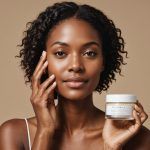Understanding Sensitive Skin
Sensitive skin is a condition that affects many people, often characterized by heightened reactions to various stimuli. Sensitive skin care requires an understanding of these reactions, as the skin may appear red, itchy, or dry. This condition can stem from genetic factors, environmental influences, or specific lifestyle choices.
Several common triggers can exacerbate skin sensitivity. These include harsh chemicals found in skincare products, extreme weather conditions, stress, and even certain food allergies. Identifying these triggers is crucial to avoid further irritation and maintain the skin’s natural balance.
Topic to read : Crafting radiant skin: your essential guide to an effective morning skincare regimen
Incorporating a skincare routine tailored to accommodate these unique needs is essential. When considering exfoliation for sensitive skin, gentle methods are advisable. This involves avoiding abrasive scrubs or rough cleansing tools, instead opting for mild chemical exfoliants that contain ingredients like lactic acid or enzyme-based formulations. These help to slough off dead skin cells without damaging the delicate skin barrier.
Understanding how to manage sensitive skin can transform a problematic complexion into a well-nurtured one. By focusing on gentle, targeted care approaches, individuals can achieve a healthier, more resilient skin environment. Being informed is empowering, guiding effective decisions to enhance skin well-being.
Also to read : The definitive handbook for pristine white sneakers: pro cleaning and care strategies for spotless style
Ideal Exfoliation Frequency
Determining the right exfoliation frequency is crucial for maintaining optimal skin health, particularly for those with sensitive skin. Generally, it is recommended that individuals with sensitive skin types exfoliate 1 to 2 times a week. This frequency allows enough time for the skin to recover, preventing irritation or damage from over-exfoliation.
Several factors influence the appropriate exfoliation frequency. Age is a significant determinant, as younger skin may tolerate more frequent exfoliation due to its quicker regeneration rate. In contrast, mature skin often requires a gentler approach. Skin type is another vital aspect – oily skin might need more frequent exfoliation compared to dry or sensitive skin. Climate plays a role as well; while humid and warm climates might necessitate more regular exfoliation, cold and dry conditions might require reducing the frequency to avoid excessive dryness.
Adapting your exfoliation routine over time is essential as these factors can change with lifestyle, environmental shifts, and even health status. Monitoring your skin’s response to different exfoliation products and techniques will guide any necessary alterations, ensuring that your skin remains healthy and resilient, while also being mindful of its unique needs.
Choosing the Right Exfoliants
Selecting the right exfoliant is essential for maintaining healthy skin, tailored specifically to your skin type’s needs. Among the options available are chemical exfoliants and physical exfoliants, each with unique benefits and considerations.
Overview of Physical Exfoliants
Physical exfoliants consist of products that manually slough off dead skin cells using small granules or abrasive materials. They range from scrubs containing tiny beads to brushes and cleansing mits. Easy to incorporate into a shower routine, they immediately refresh the skin. However, caution is advised; choosing gentle granules prevents microtears and irritation.
Overview of Chemical Exfoliants
Chemical exfoliants utilize active acids or enzymes to gently dissolve dead skin cells without scrubbing. Alpha hydroxy acids (AHAs) and beta hydroxy acids (BHAs) are common ingredients, each working differently. AHAs, such as glycolic acid, are water-soluble, ideal for sun-damaged and dry skin. BHAs, like salicylic acid, penetrate oil glands, beneficial for acne-prone skin.
Best Practices for Selecting Exfoliants for Sensitive Skin
When choosing exfoliants for sensitive skin, seek products with mild formulations and soothing ingredients like chamomile or aloe. Avoid harsh scrubs and overly aggressive products, as they can exacerbate sensitivity. Always perform a patch test before fully integrating a new product to ensure compatibility. This approach helps to avoid irritation and ensures optimal results.
Testing Skin Tolerance
Understanding your skin’s reaction to new skincare products is crucial in maintaining a healthy complexion. Skin tolerance testing is an important first step in identifying how your skin responds to exfoliation and other products. Techniques such as patch testing on a small area can effectively reduce the risk of adverse effects.
Techniques for Assessing Skin’s Tolerance
- Start with sensitivity testing by applying a small amount of product to an inconspicuous area, like behind your ear or on your wrist. Observe and monitor for any irritation or reactions over 24 hours.
- Utilize gradual introduction of new products into your skincare routine. Commence by using the new product once a week and progressively increase usage to enhance skin tolerance over time.
Importance of Gradual Introduction
A slow and cautious approach allows your skin to adjust, reducing the risk of unexpected reactions. This method provides an opportunity to observe how the product integrates into your skincare routine and adjusts accordingly.
Personal Experiences
Many find through personal experience that adjusting their regimen is necessary. As skin can fluctuate in sensitivity, being attuned to its needs is important. Remember, everyone’s skin responds differently, so flexibility in your routine is key to achieving optimal results.
Signs of Over-Exfoliation
Understanding the over-exfoliation symptoms of your skin is crucial in maintaining a balanced skincare routine. Indications include redness, persistent irritation, increased sensitivity, and patchy dryness. If ignored, these signs can escalate, causing the skin barrier to weaken, making recovery more challenging.
When experiencing irritated skin due to over-exfoliation, immediate action is necessary. First, discontinue using the exfoliating product and switch to a gentle cleanser. Hydrate with a soothing, fragrance-free moisturiser. Applying a cool compress can also alleviate discomfort, offering more short-term relief.
Long-term effects of over-exfoliation are more serious, leading to potential breakouts, uneven texture, and heightened sensitivity to other skincare products. Recovery is possible with patience and caution, prioritising skincare when rebuilding your routine. Consider incorporating products containing ceramides or hyaluronic acid, which aid in restoring the protective barrier.
Practising skincare caution is essential for sensitive skin types indeed. Limit exfoliation to no more than twice a week and ensure you choose products specifically formulated for delicate skin. Patch tests can prevent further irritation from unfamiliar products, helping you find the most suitable match without adverse effects.
Understanding your skin’s needs and listening to its reactions ensure optimal health and appearance.
Expert Opinions and Personal Experiences
Navigating skincare choices, especially for those with sensitive skin, can feel daunting. One of the most debated topics is exfoliation. Expert skincare advice often stresses the importance of choosing the right exfoliant. Skincare professionals frequently recommend gentle, non-abrasive options to avoid irritation. Dermatologists suggest chemical exfoliants with low concentrations of acids such as salicylic acid or lactic acid, which are tailored for sensitive skin.
Personal journeys highlight the trial-and-error path many encounter. Individuals with sensitive skin recount mixed outcomes with various products. Some find that using physical exfoliants leads to immediate tenderness and redness. In contrast, a few have shared positive experiences with carefully selected exfoliating agents, which rejuvenate their skin without adverse reactions.
Ultimately, while personal experiences are valuable, the consensus points to the importance of consulting professionals for personalized care. Understanding one’s unique skin needs through expert skincare advice can significantly reduce trial and error. Dermatologists and skincare professionals provide nuanced insights into product ingredients and regimen strategies to ensure both efficacy and safety for sensitive skin. This personalized approach ensures that sensitive skin is treated with the appropriate care and caution it deserves.
Frequently Asked Questions
Navigating the world of skincare can be overwhelming, especially when it comes to exfoliation for sensitive skin. Many people hold common misconceptions about this aspect of their skincare regime. Exfoliating sensitive skin is indeed possible, but it requires thoughtful consideration of both products and techniques.
One frequent inquiry is: “Can sensitive skin tolerate exfoliation?” The answer is yes, but with caution. It’s crucial to select products specifically designed for sensitive skin, such as mild chemical exfoliants like lactic acid, which gently removes dead skin cells without causing irritation. Physical exfoliants, like scrubs, can be too harsh and are often best avoided.
Another common concern: “How often should I exfoliate if I have sensitive skin?” An effective guideline is to start slowly, exfoliating once a week to see how your skin reacts. Observe your skin’s response and adjust the frequency as necessary.
For those considering specific products or routines, question the ingredients—avoiding alcohol and harsh chemicals is key. Always follow up exfoliation with a hydrating and soothing moisturizer to maintain your skin’s barrier.
By addressing these common concerns and implementing practical tips, you can create a responsive skincare routine that accommodates even the most sensitive skin.











